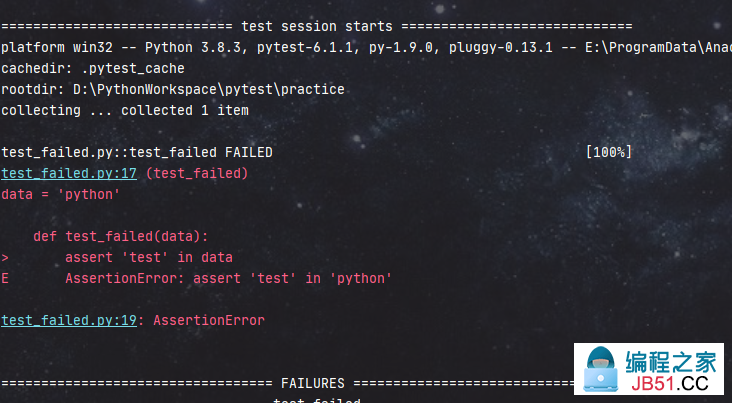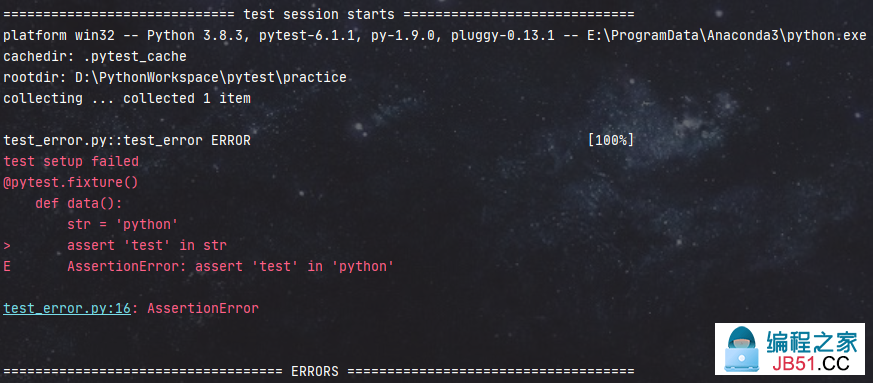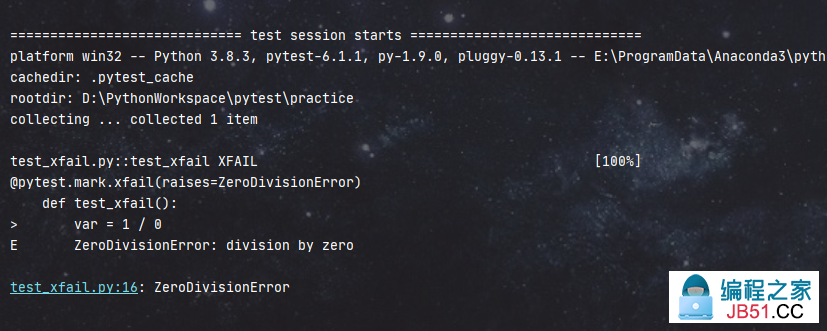常见的状态
测试通过的栗子(passed)
示例代码如下:
# -*- coding: utf-8 -*-
# @Time : 2020/10/25 17:17
# @Author : longrong.lang
# @FileName: test_pass.py
# @Software: PyCharm
# @Cnblogs :https://www.cnblogs.com/longronglang
'''
测试通过的例子
'''
import pytest
@pytest.fixture()
# 定义一个测试数据
def data():
return 1
def test_pass(data):
assert 1 == data
if __name__ == '__main__':
pytest.main(["-q","test_pass.py"])
输出结果:

断言失败的栗子(Failed)
1、正常断言失败
示例代码如下:
# -*- coding: utf-8 -*-
# @Time : 2020/10/25 17:26
# @Author : longrong.lang
# @FileName: test_Failed.py
# @Software: PyCharm
# @Cnblogs :https://www.cnblogs.com/longronglang
'''
断言失败的栗子
'''
import pytest
@pytest.fixture()
def data():
return 'python'
def test_Failed(data):
assert 'test' in data
if __name__ == '__main__':
pytest.main(["-q","test_Failed.py"])
输出结果:

2、测试方法里主动抛出异常了
示例代码如下:
# -*- coding: utf-8 -*-
# @Time : 2020/10/25 17:26
# @Author : longrong.lang
# @FileName: test_FailedException.py
# @Software: PyCharm
# @Cnblogs :https://www.cnblogs.com/longronglang
'''
断言失败的栗子
'''
import pytest
@pytest.fixture()
def data():
return 'python'
def test_Failed(data):
# 这块随便抛出一个异常了
raise IOError
assert 'py' in data
if __name__ == '__main__':
pytest.main(["-q","test_FailedException.py"])
输出结果:

代码编写上的错误(error)
1、fixture中有错
示例代码如下:
# -*- coding: utf-8 -*-
# @Time : 2020/10/25 17:34
# @Author : longrong.lang
# @FileName: test_error.py
# @Software: PyCharm
# @Cnblogs :https://www.cnblogs.com/longronglang
'''
代码编写上的错误栗子
'''
import pytest
@pytest.fixture()
def data():
str = 'python'
assert 'test' in str
return str
def test_error(data):
assert data == 'python'
if __name__ == '__main__':
pytest.main(["-q","test_error.py"])
输出结果:

fixture里面断言失败,导致fixture标记的data会报错,使得data没有返回值;而test_error调用了错误的fixture,所以error表示代码写的有问题了
2、参数不存在
示例代码如下:
# -*- coding: utf-8 -*-
# @Time : 2020/10/25 17:34
# @Author : longrong.lang
# @FileName: test_errorNoParam.py
# @Software: PyCharm
# @Cnblogs :https://www.cnblogs.com/longronglang
'''
代码编写上的错误栗子
'''
import pytest
def data():
str = 'python'
return str
def test_error(data):
assert data == 'python'
if __name__ == '__main__':
pytest.main(["-q","test_errorNoParam.py"])
输出结果:

data参数并不存在,找不到自然就error了
总结:
- 测试用例的代码有异常,包括主动抛出异常或代码有异常,都算Failed
- 当测试用例调用的fixture有异常,或传入的参数有异常的时候,都算error
- 如果一份测试报告中,error的测试用例数量越多,说明测试用例质量越差
预期失败的栗子(xfail)
这个和testng的异常测试差不多了,就是断言预期的异常,可以测试是否需要代码抛出异常或不抛出。
示例代码如下:
# -*- coding: utf-8 -*-
# @Time : 2020/10/25 17:51
# @Author : longrong.lang
# @FileName: test_xfail.py
# @Software: PyCharm
# @Cnblogs :https://www.cnblogs.com/longronglang
'''
预期失败栗子
'''
import pytest
# 断言装饰器
@pytest.mark.xfail(raises=ZeroDivisionError)
def test_xfail():
var = 1 / 0
print(var)
输出结果:

代码有异常,且和raised的异常类匹配,所以是xfail(算测试通过的一种,表示符合期望捕捉到的异常),并不算Failed
如果和raised的异常类不匹配,则是Failed

